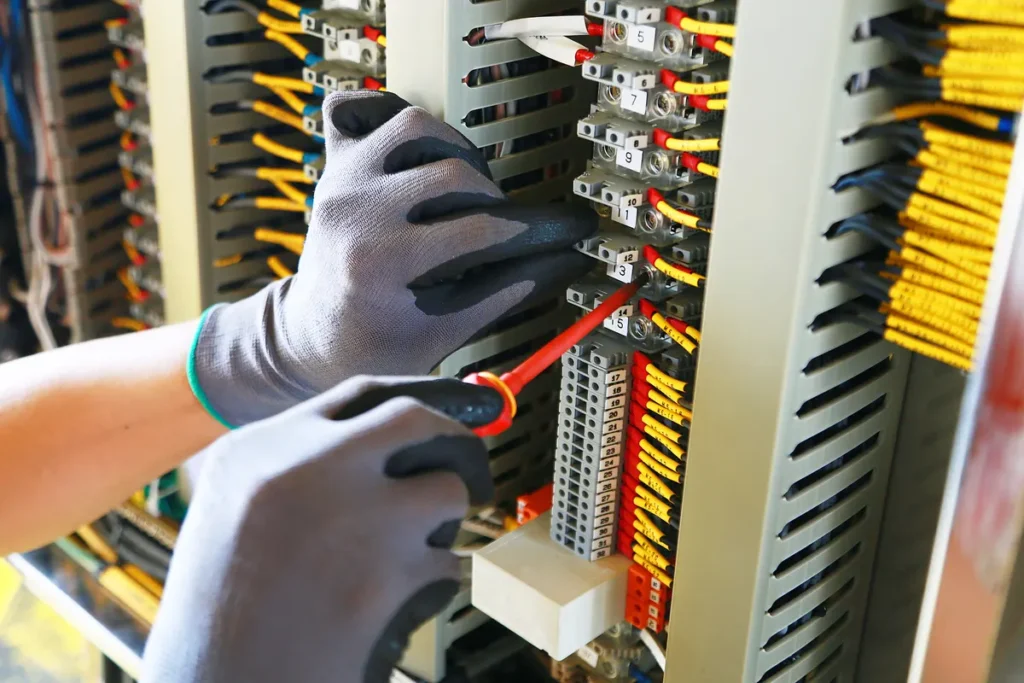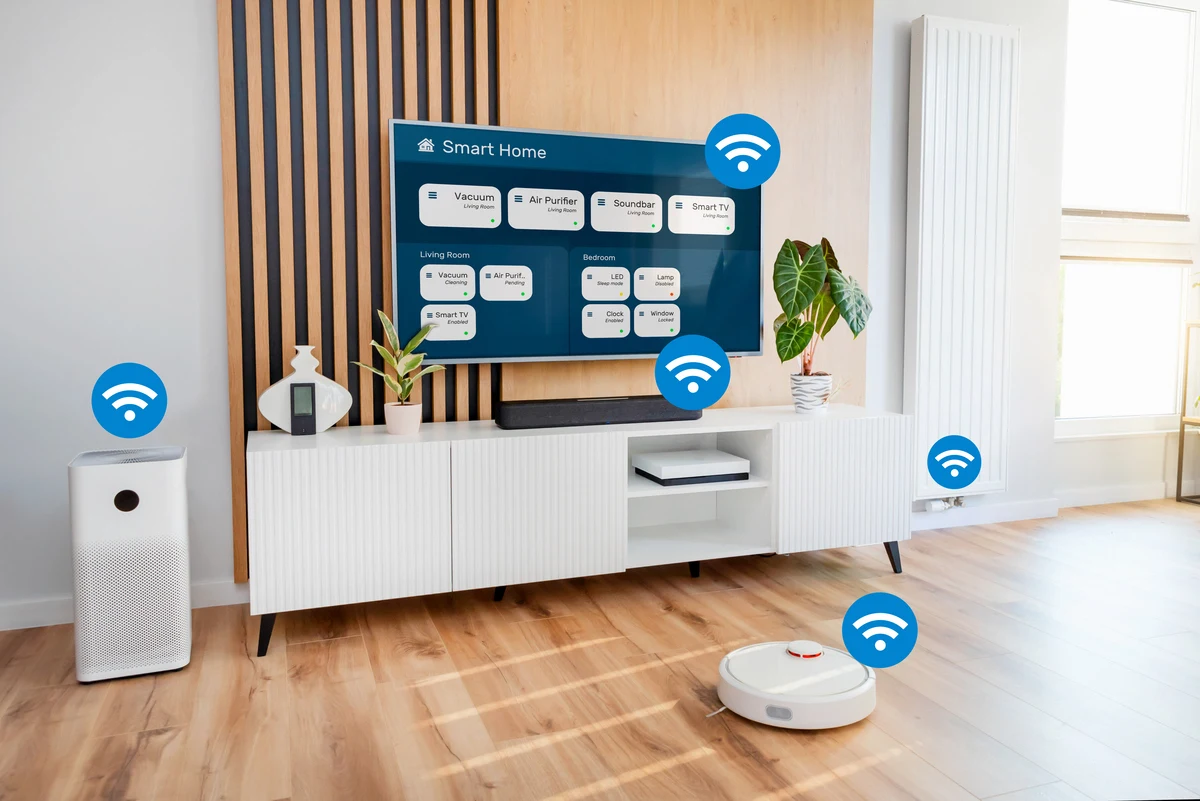There are many home automation protocols, some wired and some wireless. What are the most important protocols you should know? And what is the best protocol for your smart home?
All these questions and more are on your mind, whether you are a smart home user, thinking of converting your home to a smart one, or want to understand more details about home automation. We will cover in the article all the details you want to know about smart home protocols.
Home automation Protocols And Their Benefits?
Whether wireless or wired, the home automation protocol is a language of communication that enables all home devices to understand and communicate with each other, allowing all devices to be connected to the Internet and interact with each other. The protocol allows you to control home devices from anywhere and at any time, either through a smartphone app or through voice commands.
The main benefit of these diverse protocols lies in providing comfort and ease in managing and controlling home devices remotely. Home automation technology contributes to improving the quality of life inside homes and achieving a smart and safe living environment.
Wired Home Automation Protocols

The wired protocol for the smart automation system uses physical connections such as Ethernet cables or electrical wires to connect devices and sensors to a central control unit or hub. It is a protocol that provides more reliable and stable connections, as it is not susceptible to interference or signal loss.
Its installation requires professional expertise and drilling holes to pass the cables through walls and ceilings. So, if you are in the finishing stage and have decided to convert your home to a smart one, you should choose a trusted and highly professional company.
Advantages Of Wired Protocols
– Wired protocols provide a stable and reliable connection, unaffected by wireless interference or signal fluctuations.
– Wired connections offer a high level of security, making it difficult to breach data through cables and wires.
– Wired protocols enable high-speed data transfer, resulting in a smooth and fast user experience.
Disadvantages of wired protocols
– Wired protocols require extending cables and wires in the home, which can be complex and require additional time and effort for installation.
– Wired protocols are more costly in terms of material purchase and specialized labour for wire and cable installation.
– You can connect many devices and sensors through cables and wires, allowing for the expansion of automation and the connection of a large number of devices without the need to reconfigure the network.
KNX System

The KNX system is a building control system used in smart systems and smart homes. KNX is considered a network-based automation system, and it relies on a global standard for communication between automation devices. The KNX system consists of a variety of devices that work together to provide smart control in buildings.
This includes control devices such as tablets, smart devices, switches, sensors, lighting, heating, and air conditioning devices. All these devices are connected via network cables and programmed and configured to work together through specialized software. These devices can be controlled remotely through smart applications or central automation systems.
Advantages of the KNX system
– KNX is a globally recognized standard for building control systems, meaning that devices and components compatible with KNX can seamlessly interact with each other, regardless of the manufacturer.
– The KNX system can be easily configured to meet different needs. Devices and functions can be easily added and modified without the need to change the infrastructure.
– KNX is efficient in energy consumption, as the system can be programmed to optimize energy consumption by regulating lighting, heating, and air conditioning systems.
– KNX enables centralized control of various devices and functions in the building through simple and user-friendly user interfaces.
– KNX provides high security for data and communications, making it suitable for use in commercial and residential environments.
– The KNX system is compatible with modern technology such as smartphones and other smart devices, allowing for remote control and integration with smartphone applications.
In short, the KNX system offers a range of features that make it an ideal system for achieving smart automation and efficient control of buildings and homes.
Wireless Protocol

The wireless protocol for home automation is a protocol that does not require electrical wires; it uses wireless communication techniques such as Wi-Fi and Bluetooth to connect all devices.
The wireless protocol for home automation doesn’t need electrical wires. It uses wireless communication techniques like Wi-Fi and Bluetooth to connect all your home devices and control them remotely. If you’ve just finished decorating your home, this protocol is perfect for maintaining your home’s decor without any damage, while enjoying the benefits of a smart home.
Among the most popular wireless protocols used in home automation systems are (Zigbee / Z-Wave / Wi-Fi / Bluetooth).
Advantages of the wireless protocol
– Easy installation and connection of smart devices to the home network without the need for wiring.
– Flexible, allowing you to customize specific devices or rooms, and you can connect it yourself if you have some basic experience.
– Compatible with many smart and home devices, allowing users to connect and control a variety of devices, providing them with the choice of devices that suit their needs.
Disadvantages of wireless protocols
– Wireless protocols may be vulnerable to hacking and electronic intrusions, which can leak information related to privacy and cybersecurity.
– Wireless protocols may face interference issues with other devices operating on the same frequency, leading to communication disruptions and reduced system efficiency.
– The transmission range of wireless protocols may be limited, making it difficult to connect devices in remote areas or places with wireless signal interference.
Wireless protocol technologies are constantly evolving, and manufacturers are working to improve security and performance, making them a popular and effective choice for individuals who want to easily enhance their daily home living experience without breaking or damaging the home decor.
Z-Wave System

Z-Wave technology is a leading wireless technology that enables smart home products to communicate with each other regardless of the brand of the devices, as it is a multi-brand protocol that supports many smart devices, using a central smart hub. Z-Wave has over 20 years of experience and offers a wide range of certified products including lighting, locks, thermostats, sensors, and more.
Advantages of the Z-Wave system
– Z-Wave supports a wide range of devices, making it suitable for creating comprehensive and integrated smart home systems.
– Z-Wave devices are designed to be energy-efficient, making them suitable for battery-operated devices, which is particularly beneficial for devices like sensors.
– Z-Wave devices can be easily installed without the need for major modifications to the infrastructure.
– It provides a high level of security and data protection for communications.
– It is an international standard and maintains its current specifications through collaboration with a group of companies working to enhance and develop Z-Wave technology.
Although Z-Wave has gained fame due to its reliability and compatibility, users should consider their specific needs and device compatibility when choosing a home automation system.
ZigBee System

It is a Low-Power, Low-Rate Wireless Personal Area Network used in smart automation and remote control of smart devices. The ZigBee system is based on the IEEE 802.15.4 standard and is characterized by its ability to provide reliable wireless communication and low power consumption.
Advantages of the ZigBee system
– ZigBee is characterized by its ability to provide low-power wireless communication, making it ideal for use in battery-operated smart devices and systems.
– The ZigBee system can provide a wide range of connectivity up to hundreds of meters, making it suitable for controlling devices distributed in large spaces such as smart buildings and factories.
– The ZigBee system can form smart networks that operate independently and interact intelligently with each other, allowing for expanded coverage and increased reliability.
– The ZigBee system can easily integrate with other smart automation systems and different software, making it flexible and scalable.
– The ZigBee system provides advanced security features for wireless communications, making it suitable for use in applications that require data protection.
– ZigBee technology is used in a variety of applications including smart lighting control, smart heating, ventilation and air conditioning systems, smart security and monitoring systems, and many industrial and agricultural applications.
In short, the ZigBee system is a wireless system known for providing reliable wireless connections and low power consumption, making it suitable for various smart automation applications.
Wi-Fi System

It is one of the wireless systems used to connect smart devices in the home to the Internet. The Wi-Fi system uses IEEE 802.11 wireless communication technology and allows smart home devices such as electronics, lighting, heating and cooling devices, cameras, and security devices to communicate and be controlled remotely through smartphone apps or voice control devices.
Advantages of the Wi-Fi system
– Users can easily and quickly connect smart devices to the Wi-Fi network via smartphone apps or web interfaces.
– Wi-Fi devices can be compatible with a wide range of different smart devices from various companies and manufacturers.
– Users can expand the Wi-Fi network to cover large areas in the home by using signal repeaters or access points.
Bluetooth System

It is a wireless system that uses Bluetooth technology to connect smart devices in the home with each other. The Bluetooth system allows smart home devices such as smart speakers, lighting control devices, heating and cooling devices, and security devices to communicate wirelessly and exchange data and signals easily.
Advantages of the Bluetooth System Features
– Users can easily and quickly connect smart devices via Bluetooth technology.
– Bluetooth devices can be compatible with a wide range of different smart devices from various companies and manufacturers.
– Bluetooth technology provides a range of connections up to several meters, making it suitable for exchanging data between devices in the same room.
– Bluetooth technology can be used with voice control devices such as Amazon Echo and Google Home to easily control smart home devices.
For the smart home, there are many systems, whether based on wired or wireless protocols. Now that you know the most important smart home protocols, you can determine your smart home needs and then decide on the protocol and system you adopt in your home.
You contact us for more information.



